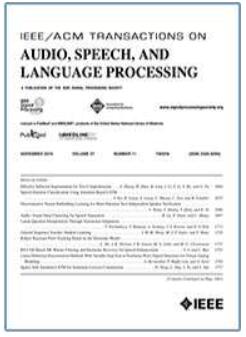自动检测粤语学龄前儿童的语音障碍
IF 5.1
2区 计算机科学
Q1 ACOUSTICS
IEEE/ACM Transactions on Audio, Speech, and Language Processing
Pub Date : 2024-09-18
DOI:10.1109/TASLP.2024.3463503
引用次数: 0
摘要
言语发声障碍(SSD)是一种发育障碍,儿童在正确发出某些言语声音时会遇到持续性困难。传统上,对 SSD 的评估主要依赖于具有相应语言背景的言语和语言病理学家(SLPs)。由于对合格语言病理学家的需求得不到满足,自动检测 SSD 对辅助临床工作、提高服务效率和质量非常有必要。本文研究了全自动检测幼儿 SSD 的方法和系统。本文开发了一种微观方法和一种宏观方法。微观系统基于检测受损儿童语音中的语音错误。通过训练深度神经网络(DNN)模型来学习辅音片段之间的相似度和对比度。通过将测试语音片段与参考片段进行对比来识别语音错误。电话级的相似性分数被汇总到扬声器级的 SSD 检测中。宏观方法利用与障碍有关的语音特征的整体变化。研究并比较了各种类型的扬声器级嵌入。实验结果表明,所提出的微观系统在电话级错误检测方面实现了 84.0% 到 91.9% 的非加权平均召回率(UAR)。所提出的宏观方法在扬声器级 SSD 检测方面的 UAR 可达到 89.0%。宏观固态硬盘检测所采用的说话人嵌入可以有效地剔除与说话人个人身份相关的信息。本文章由计算机程序翻译,如有差异,请以英文原文为准。
Automatic Detection of Speech Sound Disorder in Cantonese-Speaking Pre-School Children
Speech sound disorder (SSD) is a type of developmental disorder in which children encounter persistent difficulties in correctly producing certain speech sounds. Conventionally, assessment of SSD relies largely on speech and language pathologists (SLPs) with appropriate language background. With the unsatisfied demand for qualified SLPs, automatic detection of SSD is highly desirable for assisting clinical work and improving the efficiency and quality of services. In this paper, methods and systems for fully automatic detection of SSD in young children are investigated. A microscopic approach and a macroscopic approach are developed. The microscopic system is based on detection of phonological errors in impaired child speech. A deep neural network (DNN) model is trained to learn the similarity and contrast between consonant segments. Phonological error is identified by contrasting a test speech segment to reference segments. The phone-level similarity scores are aggregated for speaker-level SSD detection. The macroscopic approach leverages holistic changes of speech characteristics related to disorders. Various types of speaker-level embeddings are investigated and compared. Experimental results show that the proposed microscopic system achieves unweighted average recall (UAR) from 84.0% to 91.9% on phone-level error detection. The proposed macroscopic approach can achieve a UAR of 89.0% on speaker-level SSD detection. The speaker embeddings adopted for macroscopic SSD detection can effectively discard the information related to speaker's personal identity.
求助全文
通过发布文献求助,成功后即可免费获取论文全文。
去求助
来源期刊

IEEE/ACM Transactions on Audio, Speech, and Language Processing
ACOUSTICS-ENGINEERING, ELECTRICAL & ELECTRONIC
CiteScore
11.30
自引率
11.10%
发文量
217
期刊介绍:
The IEEE/ACM Transactions on Audio, Speech, and Language Processing covers audio, speech and language processing and the sciences that support them. In audio processing: transducers, room acoustics, active sound control, human audition, analysis/synthesis/coding of music, and consumer audio. In speech processing: areas such as speech analysis, synthesis, coding, speech and speaker recognition, speech production and perception, and speech enhancement. In language processing: speech and text analysis, understanding, generation, dialog management, translation, summarization, question answering and document indexing and retrieval, as well as general language modeling.
 求助内容:
求助内容: 应助结果提醒方式:
应助结果提醒方式:


